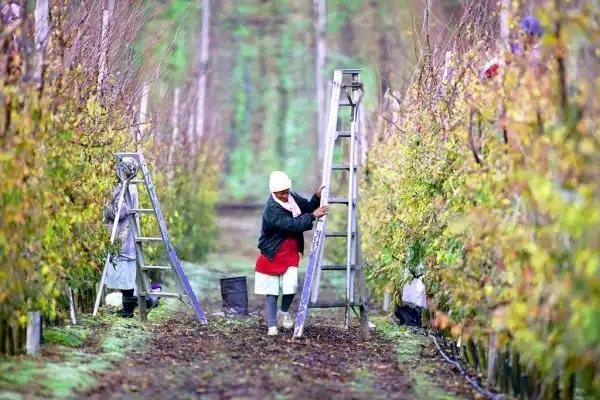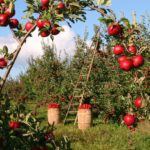The benefits of planting fruit trees and plants in shaded areas are often overlooked by gardeners and homeowners. However, there are numerous varieties of fruits that can thrive in partial shade or even full shade with the right care and attention. These plants not only add beauty to an outdoor space but also provide a source of fresh and healthy produce.
In this article, we will explore the different types of fruit trees and plants that can grow in shaded areas. We will examine the ideal growing conditions for each variety, including soil type, moisture levels, and sunlight requirements. Additionally, we will discuss common pests and diseases that may affect these plants and provide tips on how to prevent or treat them. By the end of this article, readers will have a better understanding of how to successfully grow fruit trees and plants in shady areas while reaping the benefits they provide.
Benefits Of Growing Fruit In Shaded Areas
Growing fruit in shaded areas can provide numerous benefits for both gardeners and the environment. In fact, a study conducted by the University of California Cooperative Extension found that fruit trees grown in partial shade produce higher quality fruit with better flavor than those grown in full sun. Additionally, shaded areas require less water, which can reduce the overall cost of gardening while also conserving this precious resource.
To ensure successful growth of fruit in shaded areas, it is important to follow best practices for shade gardening. This includes selecting fruit tree varieties that are well-suited for partial shade and providing them with proper soil conditions and irrigation. It may also be necessary to prune branches to allow for optimal light penetration and air circulation.
Not only do shaded fruit trees benefit gardeners, but they also have positive impacts on the environment. Shaded areas can help reduce heat island effects and improve air quality by filtering out pollutants. Furthermore, growing food locally reduces carbon emissions associated with transportation and promotes sustainable agriculture practices.
Types Of Fruit Trees That Thrive In Shade
Asian Pear Trees are an ideal choice for growing in shade, as they are considered to be one of the more shade-tolerant fruit trees. Dwarf Apple Trees, on the other hand, require more direct sunlight than Asian Pear Trees in order to thrive, yet they can still be grown in partial shade. Both Asian Pear Trees and Dwarf Apple Trees are known for their hardiness and resistance to common diseases. In general, it is advisable to choose a variety of fruit tree that is well-adapted to a particular climate and soil type when planting in the shade.
Asian Pear Trees
Walking through a garden or orchard filled with fruit trees, one cannot help but feel a sense of awe and wonder. The Asian pear tree varieties, in particular, are quite fascinating. These trees produce round, juicy fruits that have a texture similar to apples but with a flavor that is distinctly different. They require minimal maintenance and are perfect for those who want to grow fruit trees without too much fuss.
Pruning techniques for asian pear trees are essential to ensure healthy growth and high yields. It is recommended to prune the trees during their dormant period, which is in late winter or early spring. This will encourage the formation of new shoots and also help control the height of the tree. It is important to remove any dead or diseased branches as well as any crossing branches that may rub against each other and cause wounds.
In conclusion, Asian pear trees are an excellent choice for those looking to add some variety to their backyard orchard or garden space. With proper pruning techniques, these trees can thrive in shaded areas while still producing bountiful harvests of delicious fruit. So go ahead and give them a try – your taste buds (and your inner horticulturalist) will thank you!
Dwarf Apple Trees
When it comes to growing fruit trees in shaded areas, dwarf apple trees are one of the best varieties to consider. These trees typically grow up to 8-10 feet tall and can be easily maintained with proper care tips. They produce full-sized fruits that are just as delicious as those grown on larger apple trees.
To ensure optimal growth and yield, it is important to provide these dwarf apple trees with adequate water, sunlight, and nutrients. It is also recommended to prune them regularly during their dormant period, which is usually in late winter or early spring. This will help control their height and shape while promoting new growth.
When it’s time for harvesting, make sure to pick the apples when they are fully ripe and ready for consumption. Pruning techniques should also be applied during this time by removing any dead or diseased branches, as well as any crossing branches that may cause damage to the tree. With proper care and attention, dwarf apple trees can thrive in shaded areas while still producing a bountiful harvest of delicious fruits year after year.
Apple Trees For Shaded Areas
As we have previously discussed, there are several fruit trees that can thrive in shaded areas. However, when it comes to apple trees, choosing the right variety and employing effective pruning techniques are crucial factors for a bountiful harvest.
When selecting apple varieties for shaded areas, it is essential to choose ones that require less sunlight but still produce quality fruits. Some of the best apple varieties that can grow in partial shade include Liberty, Northern Spy, and Jonagold. These varieties have different maturation periods and offer various flavors and textures, making them suitable for different culinary uses.
Pruning techniques are also critical for apple trees growing in shaded areas. Pruning helps increase airflow and sunlight penetration into the tree’s canopy, which promotes optimal growth and fruit production. Proper pruning should involve removing dead or diseased branches, thinning crowded branches, and opening up the canopy to allow light penetration. By using these techniques, you can ensure your apple trees remain healthy and fruitful even in partially shaded locations.
Transitioning to Cherry Trees for Shaded Areas
While apple trees do well in partial shade with proper care, cherry trees may be an even better option for shaded areas due to their ability to thrive under low light conditions. In the next section, we will discuss some of the best cherry tree varieties that can grow in partially shaded locations and highlight essential cultivation practices that promote optimal growth and fruit production.
Cherry Trees For Shaded Areas
Cherry trees are known to thrive in full sun, but they can also grow and bear fruit in partially shaded areas. When planting cherry trees in shaded areas, it is important to consider the soil type and pruning techniques that will help them grow healthy and strong.
For cherry trees grown in shaded areas, it is best to use a soil that has good drainage and is rich in organic matter. The ideal pH range for cherry trees is between 6.0 and 6.5, so it is important to test the soil before planting. The addition of compost or peat moss can improve soil structure and fertility, while regular watering is essential during dry periods.
Pruning techniques are also important for cherry trees grown in shaded areas. Pruning should be done after the fruit has been harvested, as this will encourage new growth and promote fruit production for the following year. Dead or diseased wood should be removed immediately to prevent the spread of disease, while crossing branches should be pruned to allow more light into the tree’s canopy.
As peach trees require similar growing conditions as cherries, they too can be grown successfully in partially shaded areas with proper care and maintenance. By using similar soil types and pruning techniques as those used for cherries, peach trees can flourish in shady environments without compromising their growth or fruit production potential.
Peach Trees For Shaded Areas
Cherry trees are a great option for shaded areas, but they are not the only fruit tree that can thrive in such conditions. For those looking for a different taste and variety, peach trees are also an excellent choice. Contrary to popular belief, peach trees can grow in partial shade and produce delicious fruits.
One key aspect of growing peach trees in shaded areas is utilizing proper pruning techniques. By removing some of the branches and leaves, you can allow more sunlight to penetrate through to the tree’s core. This will promote healthy growth and ensure that your peach tree produces a bountiful harvest each year.
As with any fruit tree, it is essential to be aware of common diseases that may affect your peach tree’s health. Leaf curl, brown rot, and powdery mildew are just a few examples of diseases that can harm your tree if left untreated. By keeping an eye out for symptoms and taking preventative measures such as proper watering and fertilization techniques, you can keep your peach tree healthy for years to come.
- Here are four helpful tips for growing healthy peach trees in shaded areas:
- Choose a variety of peach tree that is known to tolerate partial shade.
- Prune regularly to allow more sunlight into the canopy.
- Keep an eye out for common diseases and take preventative measures as needed.
- Be consistent with watering and fertilization to promote optimal growth.
Transitioning into pear trees for shaded areas; while peaches make an excellent addition to any garden or orchard, some people may prefer the taste of pears instead. Luckily, there are several varieties of pear trees that can grow well in partially shaded areas.
Pear Trees For Shaded Areas
Growing conditions play a critical role in the success of pear tree cultivation. While pears require full sun exposure to thrive, there are some varieties that can tolerate partial shade. When selecting a pear tree for shaded areas, it is important to choose one that is suited to the specific climate and soil conditions of the location. Additionally, planting in a spot with good air circulation can help mitigate issues with pests and diseases.
Pruning techniques are another crucial factor in ensuring healthy pear tree growth in shaded areas. The goal of pruning is to remove dead or damaged branches and promote new growth. In shady locations, it is important to focus on thinning out the center of the tree to allow adequate light penetration. This will help prevent disease issues and ensure proper fruit development.
By selecting appropriate varieties and implementing proper pruning techniques, it is possible to successfully grow pear trees in shaded areas. However, it is important to note that these trees may not produce as much fruit as those grown in full sun conditions. Nonetheless, for gardeners with limited sun exposure, growing a few dwarf or semi-dwarf pear trees can be a rewarding experience.
Moving forward, we will explore another type of fruit tree that can thrive in shady conditions: plum trees.
Plum Trees For Shaded Areas
As we explore the world of fruit trees that thrive in shaded areas, we cannot overlook the potential of plum trees. Plum trees are a great choice for those who want to add some variety to their garden while also providing good quality fruits. These trees can grow well even in partial shade, making them an ideal choice for small gardens or yards with limited sunlight exposure.
Pruning techniques are essential for the healthy growth of plum trees. Regular pruning helps to remove dead or diseased wood and encourages new growth. It is best to prune plum trees during late winter or early spring when they are dormant. Additionally, it is important to thin out the tree’s branches occasionally so that there is adequate air circulation and sunlight penetration throughout the tree.
When choosing the best varieties of plum trees for your shaded area, consider factors such as size, flavor, and disease resistance. Some popular varieties that do well in partial shade include Stanley, which produces large blue-black fruit; Methley, a self-pollinating tree with sweet red-purple fruit; and Santa Rosa, known for its flavorful reddish-purple plums. With proper care and attention to pruning techniques, these trees can yield high-quality fruits even in shady conditions.
Moving on from plum trees, let us now explore another set of plants that can thrive well in shaded areas – berry bushes. These bushes not only provide delicious fruits but also add beauty to any garden or yard with their colorful foliage and flowers. Let us take a closer look at some popular varieties of berry bushes that are suitable for growing in shady conditions.
Berry Bushes For Shaded Areas
1.When selecting berry bushes for shaded areas, it is important to consider the types of berry bushes that are most suitable for the location. 2.The growing requirements for berry bushes in shaded areas may differ from those of berry bushes grown in sunny areas, so be sure to research the specific requirements for the type of berry bush you are planting. 3.The amount of light and water that a berry bush needs to thrive will vary depending on the species and should be taken into account when choosing a berry bush for a shaded area. 4.The soil type and pH should also be considered when selecting a berry bush for a shaded area, as this can greatly influence the health and productivity of the plant.
Types Of Berry Bushes
Berry bushes are a popular choice for gardeners who want to grow fruit in shaded areas. These plants not only provide a bountiful harvest, but they also add beauty and diversity to any landscape. Types of berry bushes that thrive in shady conditions include blueberries, raspberries, and blackberries.
Pruning techniques are crucial when it comes to the growth and development of berry bushes. Regular pruning helps to stimulate growth and encourage fruit production. It is recommended to prune in the late winter or early spring before new growth begins. Additionally, companion planting can be beneficial for berry bushes as certain plants can help repel pests and attract pollinators.
Blueberry bushes are an excellent choice for shaded areas as they require partial shade to produce their delicious berries. Raspberries also do well in partially shaded locations, but they require a bit more maintenance as they tend to spread quickly. Blackberries are another great option for shady spots, but they need full sun exposure for optimal fruit production. With proper care and attention through pruning techniques and companion planting, these types of berry bushes can thrive in any shaded area.
Growing Requirements
When it comes to growing berry bushes in shaded areas, understanding their growing requirements is crucial. Berry bushes generally prefer well-draining soil that is slightly acidic with a pH between 4.0 and 5.5. It is also important to ensure that the soil has adequate moisture retention, as berry bushes require consistent watering throughout the growing season.
Companion planting can be an effective way to improve the growth and health of berry bushes in shaded areas. Certain plants such as marigolds and chives can help repel pests, while others like clover and vetch can provide nitrogen fixation to the soil. Additionally, container gardening can be a viable option for those who lack garden space or need more control over their growing conditions.
In summary, understanding the growing requirements of berry bushes is essential when cultivating them in shaded areas. Companion planting and container gardening are two techniques that can help improve their growth and overall health. With proper care and attention, berry bushes can thrive in any shady location, providing a bountiful harvest and adding beauty to any landscape.
Blueberry Bushes For Shaded Areas
Blueberry bushes are a popular choice for gardeners who want to grow fruit in shaded areas. These plants can thrive with as little as 4 hours of sunlight per day, making them ideal for planting under trees or near buildings that cast shade. When selecting blueberry varieties for shaded areas, look for those that are specifically bred for low-light conditions.
To ensure healthy growth and good fruit production from your blueberry bushes, it is important to use proper pruning techniques. Pruning should be done in late winter or early spring before new growth begins. Remove any dead or damaged branches, and thin out the center of the bush to allow more light and air circulation. This will promote better fruit development and help prevent disease.
Companion planting ideas for blueberry bushes include interplanting with herbs such as thyme or rosemary, which can repel pests and improve soil quality. Planting acid-loving plants like azaleas or rhododendrons nearby can also benefit blueberries by creating a more acidic soil environment. Be sure to avoid planting near black walnut trees, as they release toxins that can harm blueberries.
Markdown list:
- Choose varieties bred for low-light conditions
- Prune in late winter/early spring before new growth
- Interplant with pest-repelling herbs like thyme or rosemary
- Avoid planting near black walnut trees
Transition: As we have seen, blueberry bushes are an excellent choice for shaded areas due to their low-light tolerance and versatility in companion planting options. However, if you’re looking to add even more diversity to your shaded fruit garden, consider raspberry bushes as another viable option.
Raspberry Bushes For Shaded Areas
- There are several varieties of raspberry bushes which can be grown in shaded areas, including red, yellow, and black raspberries.
- Planting raspberry bushes in shaded areas requires well-draining soil, ample sunlight, and adequate moisture.
- Pruning and maintenance of raspberry bushes in shaded areas should be done in late winter or early spring.
- Pruning should focus on removing dead or weak canes, and thinning out overgrown canes.
- Fertilizing raspberry bushes in shaded areas should be done in spring or early summer.
- Mulching should be done in the spring or summer to help keep the soil moist and retain heat.
Raspberry Varieties
When it comes to raspberry bushes that thrive in the shade, there are a few varieties worth considering. One popular choice is the Heritage raspberry, known for its abundant and flavorful fruit. Another option is the Caroline raspberry, which produces large, firm berries that are perfect for making jams and jellies. Both of these varieties require slightly different pruning techniques to maximize their yield.
To keep Heritage raspberries healthy and productive, it’s important to prune them annually in late winter or early spring. This involves removing any dead or diseased canes and thinning out crowded growth to allow more air and light to reach the remaining canes. Caroline raspberries, on the other hand, benefit from summer pruning after fruiting has finished. This helps to promote new growth and increase yields in subsequent seasons.
In terms of ideal growing conditions for both varieties, raspberries prefer well-drained soil that is rich in organic matter. They also require consistent moisture throughout the growing season and benefit from regular fertilization with a balanced fertilizer. With proper care and maintenance, raspberry bushes can provide an abundance of delicious fruit even in shaded areas of the garden or orchard.
Planting Requirements
Planting requirements are crucial to the growth and productivity of raspberry bushes, especially when it comes to those that thrive in shaded areas. To ensure successful growth, planting techniques must be carefully considered. Raspberry bushes should be planted in early spring or late fall, when the soil is moist and temperatures are cool.
Soil preparation is also an important factor in planting raspberry bushes. It is essential to choose a well-drained soil that is rich in organic matter. Prior to planting, the soil should be tilled and amended with compost or aged manure to improve its texture and fertility. This will provide the necessary nutrients for healthy root development and overall plant growth.
Aside from proper planting techniques and soil preparation, consistent watering and fertilization are also key factors in maintaining healthy raspberry bushes. Adequate moisture levels throughout the growing season will help prevent fruit from becoming dry and shriveled. Regular fertilization with a balanced fertilizer will provide essential nutrients for maximum fruit production. By following these guidelines for planting requirements, gardeners can successfully grow raspberry bushes even in shaded areas of their gardens or orchards.
Pruning & Maintenance
Once raspberry bushes have been planted in shaded areas, proper pruning techniques and maintenance must be implemented to ensure maximum fruit production. Pruning is an essential practice that promotes healthy growth, prevents disease, and increases productivity. The best time to prune raspberry bushes is in late winter or early spring while the plants are still dormant. During this period, gardeners can easily identify dead or diseased wood and remove them to prevent the spread of pests or diseases.
Aside from pruning, pest prevention is also a necessary aspect of maintaining healthy raspberry bushes. Common pests that affect raspberry bushes include aphids, spider mites, and Japanese beetles. To prevent infestations, regular monitoring of the plants should be conducted. Gardeners must also keep their gardens clean by removing fallen leaves and debris as these serve as hiding places for pests.
Regular maintenance practices such as watering and fertilization should also be continued throughout the growing season to ensure optimal plant growth and fruit production. Adequate irrigation levels should be maintained to avoid drought stress which may lead to reduced fruit size or yield. A regular application of balanced fertilizer will provide necessary nutrients for healthy plant development. By regularly implementing these practices, gardeners can successfully grow raspberry bushes even in shaded areas of their gardens or orchards with high productivity and minimal pest problems.
Blackberry Bushes For Shaded Areas
Blackberry bushes are a great option for shaded areas due to their ability to tolerate limited sunlight. They thrive in moist, well-drained soils with a pH range of 6.0-6.5. It is important to choose the right cultivar for the location as certain varieties perform better in low light conditions than others.
When planting blackberries in shaded areas, it is important to consider pruning techniques. Pruning helps maintain plant health and increase yield by removing dead or diseased canes and promoting new growth. For blackberries grown in shady areas, it is recommended to prune more aggressively to allow for increased light penetration into the canopy.
Ideal planting locations for blackberries in shaded areas include along fences, under trees or other structures that provide some protection from direct sunlight. It is important to note that while blackberries can tolerate shade, they still require at least 4-6 hours of direct sunlight per day during their growing season to produce fruit.
Moving forward, it is important to consider soil and moisture requirements for shade-loving fruit. By understanding the needs of the plants we grow, we can ensure successful growth and harvests year after year.
Soil And Moisture Requirements For Shade-Loving Fruit
- Shade-loving fruits require particular soil and moisture conditions to thrive.
- The pH of the soil should be kept between 5.5 and 6.5 to promote healthy growth.
- Watering frequency should be monitored to ensure the soil is kept moist without being overly saturated.
- Mulch should be applied to conserve soil moisture and reduce the frequency of watering.
- Applying mulch in the fall should be done in order to protect the soil from extreme temperatures.
- Mulch should be kept several inches away from the trunk of the fruit tree or plant to prevent rot or disease.
Soil Ph
The pH level of the soil is an essential factor to consider when it comes to planting shade-loving fruit trees and plants. The ideal range for most fruit trees and plants is between 6.0 and 7.0, which is slightly acidic to neutral. However, some fruits such as blueberries, cranberries, and rhododendrons prefer more acidic soil with a pH level of around 4.5 to 5.5. Adjusting soil pH can be done by adding or removing certain elements from the soil.
Nutrient deficiencies can also arise if the soil pH is not suitable for the specific plant’s needs. For instance, if the soil is too alkaline, iron and manganese may become unavailable to the plant roots leading to chlorosis or yellowing of leaves. Similarly, in acidic soils where aluminum toxicity may occur, root growth may be impeded, leading to stunted growth in plants such as peach trees. Therefore, maintaining an optimal pH level in your shade garden will ensure your fruit trees and plants are getting all the necessary nutrients for healthy growth.
In conclusion, knowing how to adjust soil pH levels in your shade garden is crucial for successful fruit tree cultivation. Soil testing kits are readily available at most garden centers or online stores and can help you determine your garden’s current pH level so that you can take appropriate action if needed. Remember that different types of fruit trees have varying preferences when it comes to soil acidity levels; hence it’s vital to research their requirements before planting them in your garden.
Watering Frequency
Watering frequency is another crucial factor to consider when it comes to cultivating shade-loving fruit trees and plants. The amount of water required by plants depends on various factors such as soil composition, climate, and the plant’s growth stage. Overwatering or underwatering your fruit trees and plants can lead to stress, diseases, and poor yields. Therefore, it’s essential to learn appropriate watering techniques for different types of fruit trees.
When watering shade-loving fruit trees and plants, it’s crucial to ensure that the water penetrates deep into the soil. Shallow watering sessions may encourage shallow root systems that are susceptible to drought stress. On the other hand, too much water can lead to root rot disease. In general, young fruit trees require more frequent watering than mature ones since their roots aren’t fully established yet. It’s also advisable to avoid overhead watering since it can promote fungal diseases in some fruits such as strawberries.
In conclusion, understanding proper watering techniques for your shade garden is vital for successful fruit tree cultivation. It’s important to monitor your plants’ moisture needs regularly and adjust your watering schedule accordingly. Additionally, adding organic matter such as compost to your soil can help retain moisture while improving soil structure and fertility over time. By taking appropriate steps towards maintaining optimal soil moisture levels in your garden, you’ll be able to enjoy healthy yields of delicious fruits year after year.
Mulch Management
Another important aspect of maintaining optimal soil moisture levels in your shade garden is proper mulch management. Mulching involves applying a layer of organic or inorganic material on the soil surface around the base of your fruit trees and plants. Mulch application helps regulate soil temperature, reduce evaporation, prevent erosion, and improve soil structure over time. Organic mulches such as bark chips, straw, leaves or grass clippings also break down over time, adding valuable nutrients to the soil.
Mulching also aids in weed control by blocking sunlight from reaching weed seeds that lie dormant in the soil. As a result, fewer weeds will germinate and compete with your fruit trees and plants for water and nutrients. However, it’s crucial to avoid piling mulch too high around the base of your fruit trees since this can lead to stem rot disease or attract pests such as rodents.
In conclusion, proper mulch management is essential for maintaining optimal moisture levels in your shade garden while reducing weed competition and improving soil fertility over time. By applying a layer of organic or inorganic material around the base of your fruit trees and plants, you’ll be able to enjoy healthy yields of delicious fruits year after year without worrying about drought stress or weed growth.
Sunlight And Temperature Needs
While some fruit trees and plants thrive in shady areas, most still require a certain amount of sunlight to grow and produce fruit. It is important to note that the amount of sunlight needed varies between species, but as a general rule, fruit trees and plants require at least six hours of direct sunlight daily. Lack of sufficient sunlight can result in stunted growth, poor fruit quality, and susceptibility to diseases.
Temperature is another important factor to consider when growing fruit trees and plants. Most varieties prefer warm temperatures ranging from 60-85°F during the day and 40-60°F at night. However, some species can tolerate colder temperatures depending on their origin. It is important to understand the temperature requirements of each plant species before planting them in specific locations.
When deciding where to plant fruit trees or plants, it is essential to take into consideration both sunlight and temperature needs. While some may prefer shadier areas with cooler temperatures, others may require full sun exposure with warm temperatures. By understanding these requirements, gardeners can make informed decisions about where to plant their fruit trees or plants for optimal growth and production yields. In the subsequent section, we will discuss common pests and diseases that affect fruit trees and plants.
Common Pests And Diseases
Fruit trees and plants that grow in the shade are not immune to pests and diseases. In fact, some of these issues can be more prevalent due to the lack of sunlight and airflow. Some common pests that may affect shade-grown fruit trees include aphids, scale insects, and mites. These small insects can cause damage to the leaves and fruit of the tree if left untreated. Common diseases that may affect shade-grown fruit trees include powdery mildew, leaf spot, and fire blight. These diseases can cause discoloration or wilting of leaves or fruit.
Prevention methods for pests and diseases in shade-grown fruit trees include promoting good air circulation by pruning branches, removing dead wood, and thinning out excess growth. Additionally, maintaining proper irrigation practices can help prevent fungal growth that leads to disease. Using natural predators such as ladybugs or lacewings can also help control pest populations without using harmful pesticides.
Treatment options for pests and diseases in shade-grown fruit trees may include chemical pesticides or fungicides as a last resort if prevention methods are unsuccessful. However, it is important to consult with a professional before using these chemicals to ensure safe application and minimal harm to beneficial insects.
Next section: Tips for Successful Fruit Growing in Shade
Tips For Successful Fruit Growing In Shade
Common pests and diseases can be a major hindrance to successful fruit growing. It is important to identify and address these issues as soon as possible to prevent their spread. However, another crucial factor in fruit growth is the amount of sunlight it receives. Some fruit trees and plants can grow in partial or full shade, but it is essential to keep in mind the specific requirements of each species.
When attempting to grow fruit in the shade, it is important to focus on soil quality. The soil should be well-draining, nutrient-rich, and ideally have a pH level between 6-7. Soil quality can greatly affect the growth and yields of fruit trees and plants. Incorporating compost or other organic matter into the soil can also improve its texture and fertility.
Pruning techniques are also critical for maximizing yield when growing fruit in the shade. Proper pruning helps maintain tree health by removing dead or diseased wood, promoting airflow, and allowing sunlight to reach more areas of the plant. Companion planting can also be beneficial when growing fruit in the shade. Planting certain species together can increase pollination rates, deter pests naturally, and provide additional nutrients through symbiotic relationships between plants.
As a horticulturalist or plant expert, it is essential to understand that not all fruits thrive in shaded areas but with good soil quality and proper pruning techniques one can maximize yield even with minimal sunlight availability. Companion planting may also help in boosting yield while keeping pests at bay naturally. Understanding how these factors interact with each other provides an opportunity for gardeners to achieve success even when faced with less-than-ideal conditions for fruit growth.
Conclusion
Fruit trees and plants that grow in the shade present a unique opportunity for gardeners to utilize underutilized spaces in their gardens. The benefits of growing fruit in shaded areas are manifold, including reduced water needs, lessened sun damage to fruit, and increased yield. Several fruit trees thrive in shaded areas, such as apple, cherry, and peach trees. These trees require specific soil and moisture requirements and have distinct sunlight and temperature needs.
To successfully grow fruit in shaded areas, gardeners must take into account common pests and diseases that can affect these plants. Diligent monitoring of plant health is essential to prevent infestations or disease outbreaks. To maximize yield, gardeners should follow tips such as regular pruning to promote healthy growth, using organic fertilizers to improve soil fertility, and planting companion plants that deter pests.
Overall, successful fruit growing in shade requires careful attention to detail and a willingness to experiment with different techniques. Gardeners who embrace this challenge can reap the rewards of abundant yields of delicious fruits while creating beautiful gardens filled with thriving plants that offer both beauty and function. With diligent care and attention, anyone can find success with fruit trees and plants that grow in the shade.
Image Credits
- “Worker pruning fruit trees” by World Bank Photo Collection (featured)





























